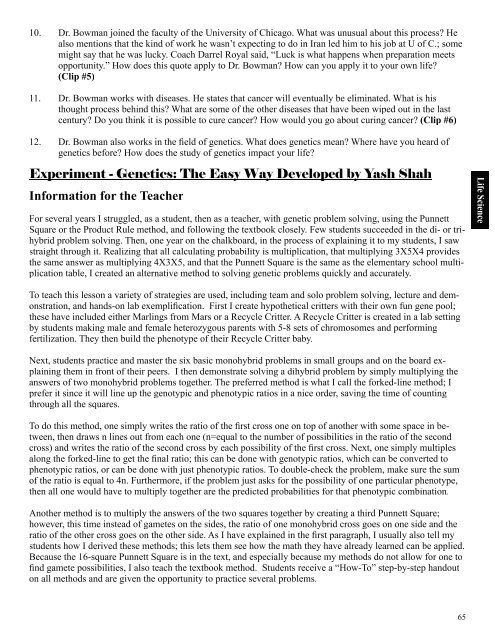ScienceMakers Toolkit Manual - The History Makers
ScienceMakers Toolkit Manual - The History Makers
ScienceMakers Toolkit Manual - The History Makers
You also want an ePaper? Increase the reach of your titles
YUMPU automatically turns print PDFs into web optimized ePapers that Google loves.
10. Dr. Bowman joined the faculty of the University of Chicago. What was unusual about this process? He<br />
also mentions that the kind of work he wasn’t expecting to do in Iran led him to his job at U of C.; some<br />
might say that he was lucky. Coach Darrel Royal said, “Luck is what happens when preparation meets<br />
opportunity.” How does this quote apply to Dr. Bowman? How can you apply it to your own life?<br />
(Clip #5)<br />
11. Dr. Bowman works with diseases. He states that cancer will eventually be eliminated. What is his<br />
thought process behind this? What are some of the other diseases that have been wiped out in the last<br />
century? Do you think it is possible to cure cancer? How would you go about curing cancer? (Clip #6)<br />
12. Dr. Bowman also works in the fi eld of genetics. What does genetics mean? Where have you heard of<br />
genetics before? How does the study of genetics impact your life?<br />
Experiment - Genetics: <strong>The</strong> Easy Way Developed by Yash Shah<br />
Information for the Teacher<br />
For several years I struggled, as a student, then as a teacher, with genetic problem solving, using the Punnett<br />
Square or the Product Rule method, and following the textbook closely. Few students succeeded in the di- or trihybrid<br />
problem solving. <strong>The</strong>n, one year on the chalkboard, in the process of explaining it to my students, I saw<br />
straight through it. Realizing that all calculating probability is multiplication, that multiplying 3X5X4 provides<br />
the same answer as multiplying 4X3X5, and that the Punnett Square is the same as the elementary school multiplication<br />
table, I created an alternative method to solving genetic problems quickly and accurately.<br />
To teach this lesson a variety of strategies are used, including team and solo problem solving, lecture and demonstration,<br />
and hands-on lab exemplifi cation. First I create hypothetical critters with their own fun gene pool;<br />
these have included either Marlings from Mars or a Recycle Critter. A Recycle Critter is created in a lab setting<br />
by students making male and female heterozygous parents with 5-8 sets of chromosomes and performing<br />
fertilization. <strong>The</strong>y then build the phenotype of their Recycle Critter baby.<br />
Next, students practice and master the six basic monohybrid problems in small groups and on the board explaining<br />
them in front of their peers. I then demonstrate solving a dihybrid problem by simply multiplying the<br />
answers of two monohybrid problems together. <strong>The</strong> preferred method is what I call the forked-line method; I<br />
prefer it since it will line up the genotypic and phenotypic ratios in a nice order, saving the time of counting<br />
through all the squares.<br />
To do this method, one simply writes the ratio of the fi rst cross one on top of another with some space in between,<br />
then draws n lines out from each one (n=equal to the number of possibilities in the ratio of the second<br />
cross) and writes the ratio of the second cross by each possibility of the fi rst cross. Next, one simply multiples<br />
along the forked-line to get the fi nal ratio; this can be done with genotypic ratios, which can be converted to<br />
phenotypic ratios, or can be done with just phenotypic ratios. To double-check the problem, make sure the sum<br />
of the ratio is equal to 4n. Furthermore, if the problem just asks for the possibility of one particular phenotype,<br />
then all one would have to multiply together are the predicted probabilities for that phenotypic combination.<br />
Another method is to multiply the answers of the two squares together by creating a third Punnett Square;<br />
however, this time instead of gametes on the sides, the ratio of one monohybrid cross goes on one side and the<br />
ratio of the other cross goes on the other side. As I have explained in the fi rst paragraph, I usually also tell my<br />
students how I derived these methods; this lets them see how the math they have already learned can be applied.<br />
Because the 16-square Punnett Square is in the text, and especially because my methods do not allow for one to<br />
fi nd gamete possibilities, I also teach the textbook method. Students receive a “How-To” step-by-step handout<br />
on all methods and are given the opportunity to practice several problems.<br />
65<br />
Life Science










